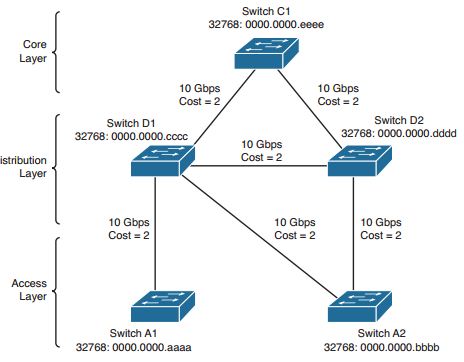CCNP Switch FAQ: Spanning-Tree Configuration
Q1. Which of these is the single most important design decision to be made in a network running STP?
a. Removing any redundant links
b. Making sure all switches run the same version of IEEE 802.1D
c. Root bridge placement
d. Making sure all switches have redundant links
Q2. Where should the root bridge be placed on a network?
a. On the fastest switch
b. Closest to the most users
c. Closest to the center of the network
d. On the least-used switch
Q3. Which of the following is a result of a poorly placed root bridge in a network?
a. Bridging loops form.
b. STP topology cannot be resolved.
c. STP topology can take unexpected paths.
d. Root bridge election flapping occurs.
Q4. Which of these parameters should you change to make a switch become a root bridge?
a. Switch MAC address
b. Path cost
c. Port priority
d. Bridge priority
Q5. What is the default base 802.1D STP bridge priority on a Catalyst switch?
a. 0
b. 1
c. 32,768
d. 65,535
Q6. Which of the following commands is most likely to make a switch become the root bridge for VLAN 5, assuming that all switches have the default STP parameters?
a. spanning-tree root
b. spanning-tree root vlan 5
c. spanning-tree vlan 5 priority 100
d. spanning-tree vlan 5 root
Q7. What is the default path cost of a Gigabit Ethernet switch port?
a. 1
b. 2
c. 4
d. 19
e. 1000
Q8. What command can change the path cost of interface Gigabit Ethernet 1/0/3 to a value of 8?
a. spanning-tree path-cost 8
b. spanning-tree cost 8
c. spanning-tree port-cost 8
d. spanning-tree gig 1/0/3 cost 8
Q9. What happens if the root bridge switch and another switch are configured with different STP Hello timer values?
a. Nothing; each sends hellos at different times.
b. A bridging loop could form because the two switches are out of sync.
c. The switch with the lower Hello timer becomes the root bridge.
d. The other switch changes its Hello timer to match the root bridge
Q10. What network diameter value is the basis for the default STP timer calculations?
a. 1
b. 3
c. 7
d. 9
e. 15
Q11. Where should the STP PortFast feature be used?
a. An access layer switch port connected to a PC
b. An access layer switch port connected to a hub
c. A distribution layer switch port connected to an access layer switch
d. A core layer switch port
Q12. Where should the STP UplinkFast feature be enabled?
a. An access layer switch.
b. A distribution layer switch.
c. A core layer switch.
d. All these answers are correct.
Q13. If used, the STP BackboneFast feature should be enabled on which of these?
a. All backbone or core layer switches
b. All backbone and distribution layer switches
c. All access layer switches
d. All switches in the network
Q14. Which one of the following commands enables you to verify the current root bridge in VLAN 10?
a. show root vlan 10
b. show root-bridge vlan 10
c. show spanning-tree vlan 10 root
d. show running-config
More Resources
